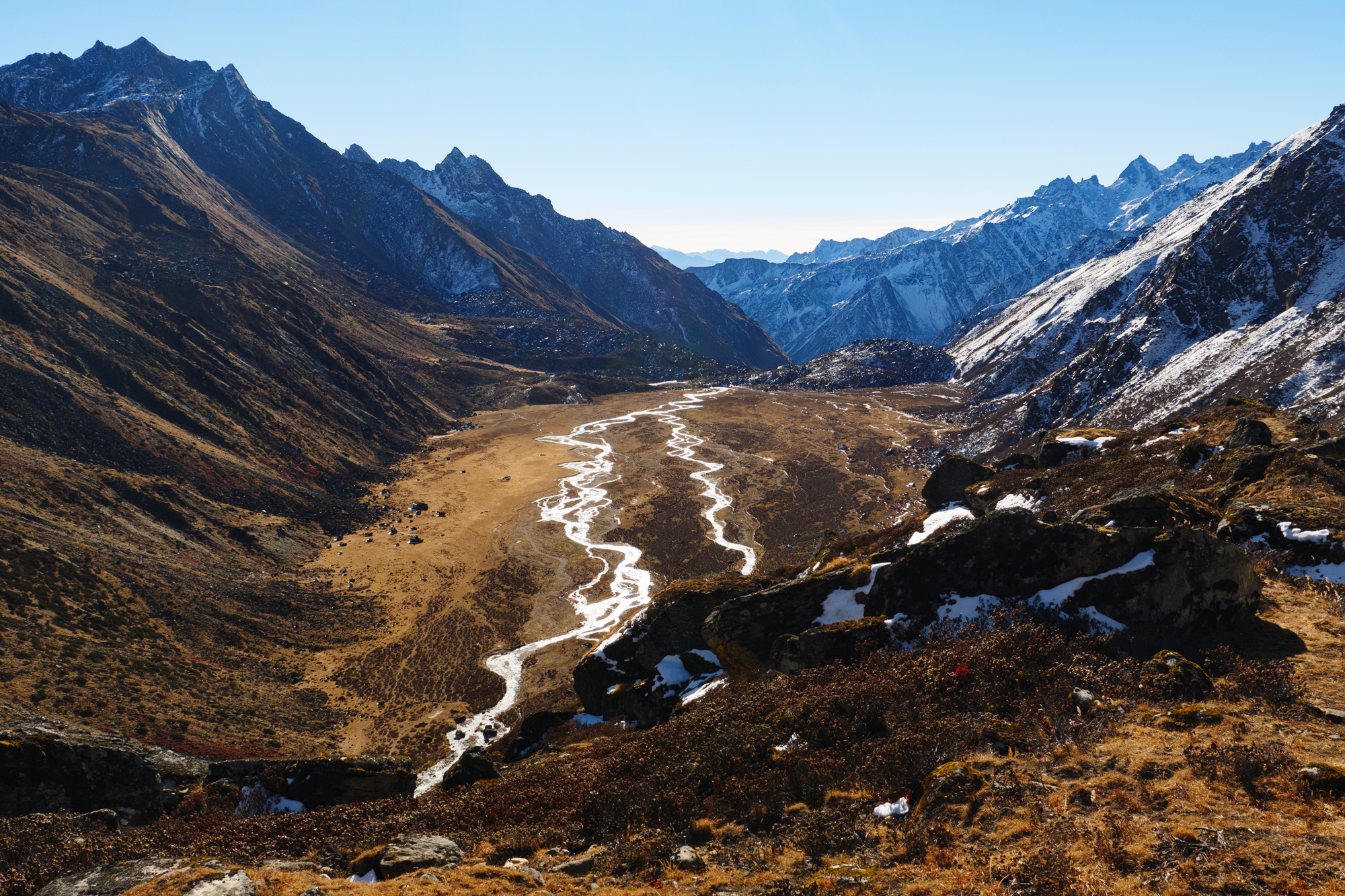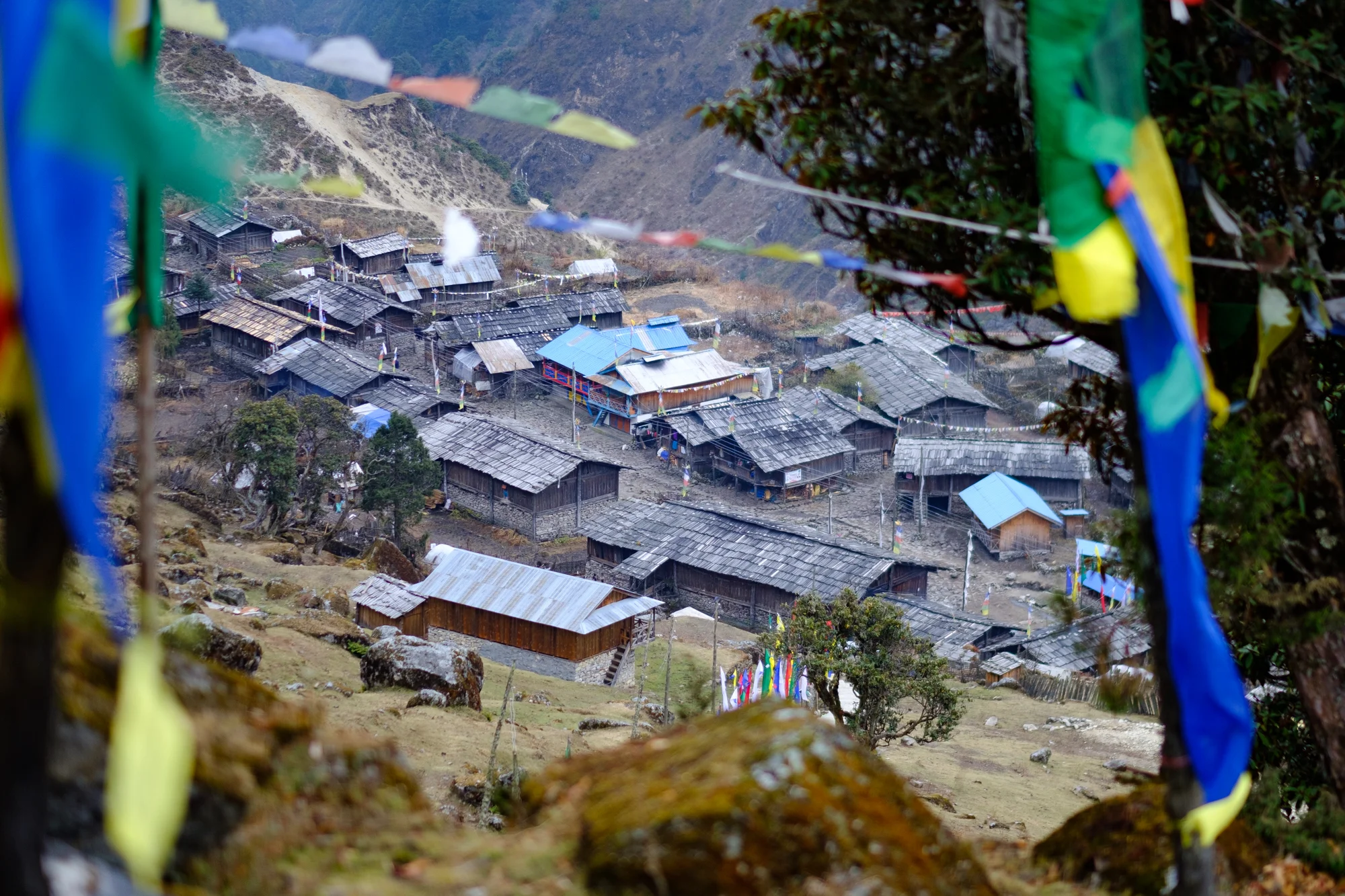The Lumba Sumba Trek, Kanchenjunga Region, Nepal - Planning and Advice
LUMBA SUMBA PHOTO GALLERY HERE
Thirty years ago I travelled to Nepal. In my teens, it was my first overseas trip. I trekked to Everest Base Camp, spending almost a month in the region. Taking a bus to the road-head in Jiri, I followed the walking track up to basecamp and the peak of Kallar Patar, then back out again. Even back then, there were small teahouses strung all along the way. Only a handful of other trekkers made their way along the Khumbu trail. At the higher altitudes, conditions became more primitive. At Gorak Shep, the final night before basecamp, there was only one smokey single room lodge. No toilet. Now, there is a whole village of guesthouses up there. This was before the internet, cell phones, electricity and the need to charge device batteries. The only food available was Dal Bhat.
Since then, Nepal, the Everest region and indeed the world have changed. Trekking has become a more significant industry. The infrastructure and volume of trekkers is enormous. If that helps the locals and puts money into the Nepali economy, then that is a good thing. However, for me personally, when I decided last year to return to Nepal, I wanted to find a trek that would give me a similar sense of adventure to my previous journey. Something a bit rugged, undiscovered and off the beaten track. Surely those places still exist?
As it turns out, they do. After some online research, I learned about a trek called the Lumba Sumba. It is in a little-known region, the remote Eastern Himalaya of Nepal. The trail traverses the mountains between the third and fifth highest in the world - Kanchenjunga and Makalu. It passes through rarely visited Sherpa and Limbu villages, rugged valleys and up to the spectacular Lumba Sumba pass (about 5200 meters above sea level) itself. I saw some intriguing photos of the remote villages of Olangchung Gola and Thudam, which encouraged me to go even more.
The Lumba Sumba was only opened to foreign trekkers in 2012. But even now (2018), very few outside visitors go there. Although there are teahouses in many villages, up towards the pass, the trek requires at least three or four nights of camping. Many people camp for the whole trek, but mixing it up with a combination of simple lodges and camping worked for me. It’s nice to stay with and meet the locals. As it turned out, once we had left the Kanchenjunga trail, we didn’t see a single foreign trekker for about two weeks. We were late in the season (November), but I expect if you visit at any time trekker numbers will be low.
One of the reasons both Kanchenjunga and Lumba Sumba see so few trekkers is that these routes appear harder to organise. Both treks are less accessible, they require special permits, a guide and you need to camp for part of the way (for the Lumba Sumba - for Kanchenjunga there are lodges). For these reasons, many of the trekkers that do make it out to the region go in organised groups. But these obstacles are less of a problem than they might initially seem. In our case, we got the correct permits via an agency (Wilderness Excursions), but we organised the trek independently with just our own guide (Prakash) and a porter (Sandesh). With one flight and an eight-hour jeep ride you can reach the start of the trek in a day - more accessible than it might seem
How Do You Get There?
There is an airstrip at Suketar - near the start of the trek at Taplejung. But it appears that flights to this airport are rare, at best erratic. We were informed - via an insider - that all the planes had been requisitioned to the much more in demand route to Lukla - the jumping off point for the Everest region. So, there were no flights while we were there. We read one online report saying flights to Suketar would be resumed shortly, but this seemed unreliable.
Instead, we took the 8am flight from Kathmandu to Bhadrapur - with beautiful mountain views - then a jeep from there up to Taplejung. The trip was under an hour (with excellent views of Everest), and the vehicle took about 8 hours. Our driver drove like a maniac to do it that fast so I couldn’t imagine doing it any faster. The cost of the jeep was 13,000 rupees.
Bhadrapur airport appears to be in the middle of nowhere, so don’t take the flight and expect to find a jeep on arrival (or even a local taxi for that matter). Again, we got Wilderness Excursions to organise the vehicle in advance for us. I think if you don’t have the Jeep arranged in advance, it will take several hours or even a day to organise one. You would likely have to stay in Bhadrapur for the night. Best plan ahead.
The drive itself is quite pleasant - a sealed but very windy road up through the verdant hills and tea plantations around Ilam. It is a region of big, green, open valleys and attractive villages packed in along narrow ridges. In Taplejung we stayed at the Hotel Jara, which wasn’t signposted and is hidden down a side street. You will need to find someone to point you in the right direction. It was a dirty, dark and overpriced, but we were told by our driver it was the best option in town. The only other place I saw was more obviously located by the bus station - but that looked even more squalid.
In the morning we took another Jeep for the far end of Taplejung up a very rough road via the airstrip at Suketar to the road head at Phedi - which is the jumping off point to Pathibhara Devi temple. Most trekkers are likely to skip the route we took to Pathibhara and take the more usual road from Suketar up the Tamur valley. This road continues all the way to Lelep now, although it seems vehicles can only go as far as Taplethok. When we walked up to it there just seemed to be a couple of cars a day, all looking very full, hot and uncomfortable. It is an enjoyable walk, so unless you are short on time, travelling on foot is still the best option.
What Permits Do You Need?
You need a restricted area permit for this trek, issued by a Trekking Agency. These also require that you take a guide and have a minimum of two trekkers in the group. Again, we used Wilderness Expeditions to organise our permits, and our guide was an independent operator, Prakash. Prakash was excellent and very experienced, and he was also happy to porter a lot of equipment and cook when necessary.
What Should I Bring?
Unless you don’t mind sleeping in caves, or out in the open, you need to bring a tent, sleeping bag, mattress, cooking equipment and food for at least four days of this trek. Once you pass Olangchang Gola, there are very few people (we saw no-one) for at least three nights. In summer there may be Yak herder camps. When you get to Thudam, on the other side of the Lumba Sumba pass, they aren’t really set up to provide for trekkers. A local could probably provide you with basic shelter, but they don’t have much food. Unless you walk a very long day (or you could sleep in herders huts), you also need a tent for between Thudam and Chayamtang. Although cold, at higher altitudes it was quite clear, and there wasn’t a lot of snow when we did this trek. But I imagine that isn’t always the case, so you should take a tent.
There are some basic shops in villages along the way so you can buy a few very supplies, but don’t rely on anything.
What Food Should I Bring?
Dal Bhat and occasionally Chowmein are available in most of the villages - but these are your only options. The former is easier to find, although it can often take over an hour to make. As Nepalese don’t really eat breakfast, there aren’t many options in the morning. Although in a few places we managed to rustle up an Omelette. The usual trekker/tourist fare of pizza, pasta and so on is unheard of. In some lodges, you can get soft drinks and beer, but as most places don’t have surplus electricity, they won’t be cold. The local brew is Tongba - drunk warm with a bamboo straw from those appealing wooden vessels.
For most of the trek we ate in local teahouses, but once north of Olangchung Gola we reverted to dried noodles, pasta and other camping food. Some of this we carried in from Kathmandu, and some (Chinese 2 minute noodles) we bought from the villages.
It is definitely recommended to bring some snacks and treats from Kathmandu. If you are relying on local supplies, the food can get quite monotonous.
Where is There Accommodation?
There are lodges in the following places, many of which we stayed in;
Phedi (on the way to Prathibara) - dozens of pilgrim guesthouses of varying standards
Lingham - an emergency roadside lodge, very basic with one room.
Chirwa - We didn’t stay in this village, but it seemed like a charming place with at least three guesthouses. This is probably a more beautiful village than Taplethok
Taplethok - not a bad basic lodge. Seemed to be a lot of drunk villagers around - possibly visiting the big smoke from up in the hills.
Lelep - One of the most excellent lodges, up on the hill by the village square. The owners seemed like a wealthy family, and the rooms were light and comfortable. Apparently, there were a couple of lodges up the hill as well.
Iladanda - not really a village, just a couple of houses, but the lodge was, and the old people who owned it were very accommodating - just off the trail and not signposted.
Olangchung Gola - a new and very comfortable lodge here, located near where you come up the hill and enter the village.
Thudam - there is no lodge. At a push, the locals might take you in, though the houses are very basic.
Chayamtang - at the far end of the village (if coming from Lumba Sumba) is a lovely lodge, although it was quite busy with locals staying. The kitchen area downstairs is nice. Thin corrugated iron walls mean it was noisy.
Linggam - competing with Lelep for the best lodge, this place had the only soft mattress and a big screen TV in the dining area (!). Nice views down the valley.
Hatiya - this pleasant village had at least three lodges, but they were all fully booked with local politicians campaigning in the area, so we camped in someone’s garden.
How Long Does it Take?
There are many variables to a trek in Nepal, but the Lumba Sumba trek takes roughly three weeks, or a little more or less depending on what parts you walk or drive, and how many acclimatisation days you choose.
The road seems to be continually extending at both ends of the trek, although really they are just wide dirt trails. On the Eastern side of the pass, you can get a jeep from Taplejung up to Taplethok (and the other way). However, this is a nice walk, and there is little to no traffic, so unless you are on a tight schedule, you might as well go on foot. The road seemed to then continue past Taplethok all the way up to Lelep. Although, there were no evidence vehicles along this section or in Lelep so it may be undrivable. The trail goes on the other side of the river to the road, so it is hard to tell what state it is in.
Similarly, at the other Western end of the trek, a new road is visible from Hatya going south, but no vehicles. The trail also doesn’t follow the road here. The first vehicles we saw were when in Barun, although they were just motorbikes. There were no Jeeps until Gola, where you can rent one (warning - they are expensive - 10,000 rupees). The road from Gola south is very rough, so get ready for a slow, bumpy ride.
How Hard is It?
The Lumba Sumba is not an easy trek, but anyone with a reasonable level of fitness and trekking experience should be able to complete it. The difficulty is because it is remote. There aren’t a lot of comforts along the way. Accommodation and food are basic.
The trail itself is rough in some sections, with the occasional landslide, large rocks, the odd river and overgrown parts. For us, the hardest section was descending from the temple of Prathibhara to the road near Chirwa. This path is rarely used, steep, overgrown and there is no water. There is a good reason why not many people go this way. I wouldn’t recommend this trail to anyone. If you do do it, take plenty of water.
The other difficult section is the two days after Thudam. This trail has a lot of ascents and descents, little water and many tricky landslides to navigate. It is a rugged back-country path, but also quite spectacular.
The Lumba Sumba is an excellent trek for people who want to experience something similar to what trekking was like in Annapurna or Everest many years ago. It is difficult, but it is an adventure. The people, villages and mountain views are as beautiful as the rest of Nepal, you just need to go to a little more effort to make it happen.







